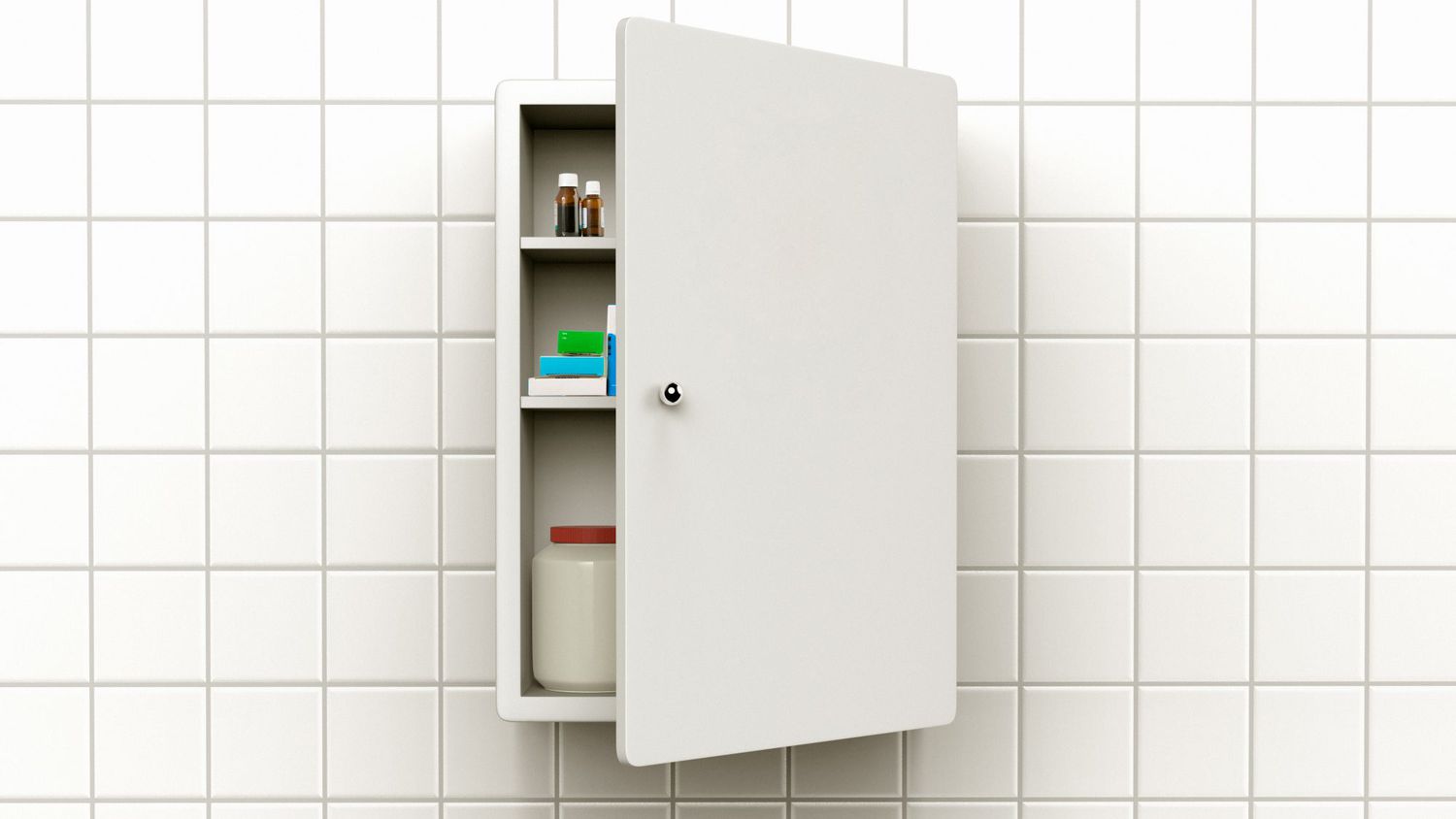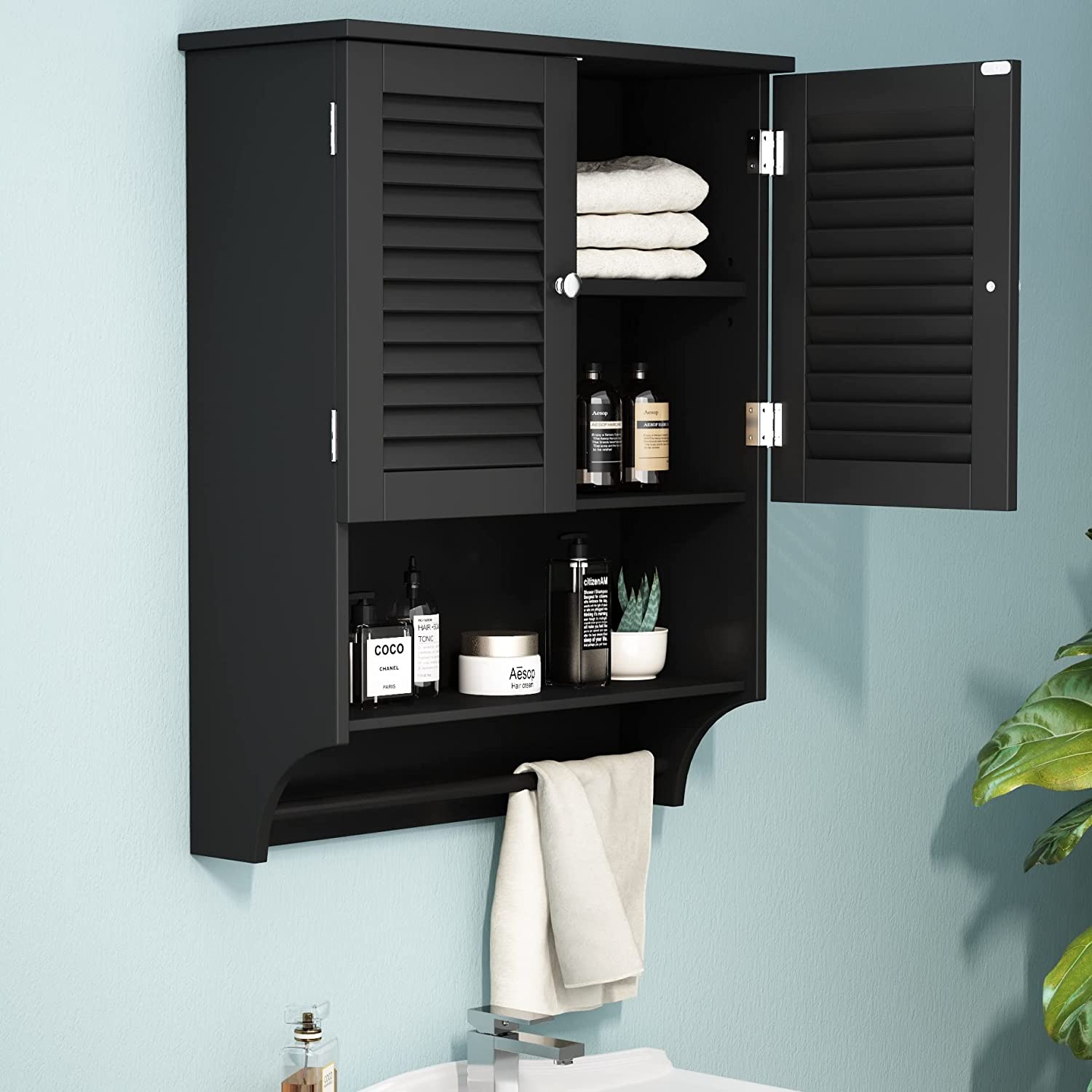Home>Furniture & Design>Bathroom Accessories>What To Have In Your Medicine Cabinet


Bathroom Accessories
What To Have In Your Medicine Cabinet
Published: February 10, 2024
Ensure you have all the essential bathroom accessories in your medicine cabinet for easy access and organization. Stock up on must-have items for a well-prepared bathroom.
(Many of the links in this article redirect to a specific reviewed product. Your purchase of these products through affiliate links helps to generate commission for Storables.com, at no extra cost. Learn more)
Pain Relief
Pain relief is a crucial component of any well-stocked medicine cabinet. Whether it's a headache, muscle ache, or minor injury, having the right pain relief medication on hand can provide much-needed comfort and relief. Here are some essential items to consider including in your medicine cabinet for effective pain management:
-
Acetaminophen (Tylenol): Acetaminophen is a versatile over-the-counter pain reliever that can help alleviate a variety of discomforts, including headaches, muscle aches, and minor arthritis pain. It's gentle on the stomach and suitable for individuals who cannot take nonsteroidal anti-inflammatory drugs (NSAIDs).
-
Ibuprofen (Advil, Motrin): Ibuprofen is a nonsteroidal anti-inflammatory drug (NSAID) that can effectively reduce pain, inflammation, and fever. It's particularly beneficial for addressing menstrual cramps, dental pain, and minor injuries. However, it's important to use ibuprofen with caution, especially for individuals with a history of stomach ulcers or kidney problems.
-
Aspirin: Aspirin is another NSAID that can provide relief from mild to moderate pain, fever, and inflammation. Additionally, it is commonly used as a preventive measure for heart attacks and strokes in individuals at risk due to its blood-thinning properties. However, aspirin should be used cautiously in children and teenagers due to the risk of Reye's syndrome.
-
Topical Analgesic Creams: Topical analgesic creams, such as those containing menthol or capsaicin, can be beneficial for localized pain relief, such as muscle strains, sprains, or arthritis. These creams work by numbing the area of application, providing temporary relief from discomfort.
-
Hot/Cold Packs: While not a medication, hot and cold packs are valuable additions to a medicine cabinet for addressing pain and swelling. Cold packs can help reduce inflammation and numb pain, while hot packs can alleviate muscle stiffness and promote relaxation.
By ensuring that your medicine cabinet is stocked with these pain relief essentials, you can be better prepared to manage unexpected discomfort and minor injuries effectively. However, it's important to use these medications as directed and consult a healthcare professional if you have any concerns or underlying health conditions.
Remember, a well-prepared medicine cabinet can provide peace of mind and convenience when it comes to addressing common aches and pains, allowing you to focus on a speedy recovery and overall well-being.
Key Takeaways:
- Be prepared for common health issues by stocking your medicine cabinet with pain relief, allergy medication, bandages, thermometer, and more. Stay ready for unexpected discomfort and minor injuries.
- Keep your medicine cabinet stocked with essential items like eye drops, antidiarrheal medication, and hydrocortisone cream to address common eye discomforts and gastrointestinal issues. Prioritize comfort and well-being for everyday health needs.
Read more: How To Organize Your Medicine Cabinet
Allergy Medication
Allergies can strike at any time, causing discomfort and disrupting daily routines. As such, having a well-equipped medicine cabinet with essential allergy medications is crucial for managing unexpected allergic reactions effectively. Whether it's seasonal allergies, food allergies, or allergic skin conditions, being prepared with the right medications can make a significant difference in alleviating symptoms and promoting comfort.
Here are some key allergy medications to consider including in your medicine cabinet:
-
Antihistamines: These medications are designed to counteract the effects of histamine, a compound released by the body during an allergic reaction. Antihistamines can help relieve symptoms such as sneezing, itching, watery eyes, and runny nose. Over-the-counter options like cetirizine (Zyrtec), loratadine (Claritin), and fexofenadine (Allegra) are popular choices for managing allergy symptoms. Additionally, diphenhydramine (Benadryl) is known for its effectiveness in addressing acute allergic reactions and providing relief from itching and hives.
-
Nasal Sprays: For individuals dealing with nasal congestion and inflammation due to allergies, nasal sprays containing corticosteroids or antihistamines can offer targeted relief. These sprays work directly in the nasal passages to reduce swelling and alleviate congestion, providing much-needed comfort for those experiencing allergic rhinitis.
-
Eye Drops: Allergic reactions can often manifest in the form of itchy, red, and irritated eyes. Including antihistamine eye drops in your medicine cabinet can help soothe eye-related allergy symptoms and provide relief from discomfort. Options such as ketotifen fumarate (Zaditor) and olopatadine (Patanol) are designed to alleviate itching and redness caused by allergic conjunctivitis.
-
Decongestants: In cases where nasal congestion is a prominent allergy symptom, oral or nasal decongestants can help alleviate congestion and improve breathing. However, it's important to use decongestants with caution, especially for individuals with high blood pressure or certain medical conditions, as they can elevate blood pressure and cause other side effects.
By ensuring that your medicine cabinet is stocked with these essential allergy medications, you can be better prepared to address allergic reactions promptly and effectively. It's important to familiarize yourself with the proper usage and potential side effects of these medications, especially if they are intended for use by family members or household guests with known allergies.
In addition to medications, it's advisable to include other allergy management essentials in your medicine cabinet, such as hypoallergenic tissues, saline nasal spray, and a HEPA air purifier for indoor allergy control. By taking a proactive approach to allergy management and maintaining a well-stocked medicine cabinet, you can minimize the impact of allergic reactions and promote a more comfortable living environment for yourself and your loved ones.
Antacids
Acid indigestion, heartburn, and stomach discomfort are common occurrences that can disrupt daily activities and cause significant discomfort. In such instances, having antacids readily available in your medicine cabinet can provide quick relief and restore comfort. Antacids are over-the-counter medications designed to neutralize excess stomach acid, alleviating symptoms such as heartburn, acid reflux, and indigestion. These medications work by raising the pH level in the stomach, reducing acidity and the associated discomfort.
When selecting antacids for your medicine cabinet, it's essential to consider the different types available and their specific benefits. Here are some key points to keep in mind:
Types of Antacids
-
Calcium Carbonate: Antacids containing calcium carbonate, such as Tums and Rolaids, are known for their rapid acid-neutralizing properties. They are particularly effective for providing quick relief from heartburn and indigestion. However, individuals with kidney problems or a history of kidney stones should use calcium carbonate antacids with caution due to the potential for elevated calcium levels in the body.
-
Magnesium Hydroxide: Antacids like Milk of Magnesia contain magnesium hydroxide, which not only neutralizes stomach acid but also has a mild laxative effect. This can be beneficial for individuals experiencing both acid-related discomfort and occasional constipation. However, excessive use of magnesium-containing antacids can lead to diarrhea and electrolyte imbalances.
-
Aluminum Hydroxide: Antacids containing aluminum hydroxide, such as Maalox and Mylanta, are known for their acid-neutralizing properties and their ability to provide longer-lasting relief compared to other antacid types. However, they may cause constipation in some individuals, and prolonged use can lead to the accumulation of aluminum in the body.
-
Simethicone: Some antacids also contain simethicone, an anti-gas ingredient that helps alleviate bloating and gas associated with indigestion. These combination antacids can provide relief from both acid-related discomfort and digestive gas, offering comprehensive symptom management.
Considerations for Usage
When using antacids, it's important to follow the recommended dosage and usage guidelines provided on the packaging or as advised by a healthcare professional. Additionally, individuals with specific medical conditions, such as kidney disease, high blood pressure, or gastrointestinal disorders, should consult a healthcare provider before using antacids, as certain formulations may not be suitable for their needs.
By including a variety of antacid options in your medicine cabinet, you can cater to different preferences and needs, ensuring that you are prepared to address acid-related discomfort effectively. Additionally, keeping antacids on hand can provide peace of mind, knowing that relief is readily available when needed.
In summary, antacids are valuable additions to any medicine cabinet, offering fast-acting relief from acid-related discomfort and promoting overall digestive comfort. By understanding the different types of antacids available and their respective benefits, you can make informed choices when stocking your medicine cabinet, ensuring that you are well-prepared to manage acid indigestion and heartburn whenever they arise.
Read more: What Is A Recessed Medicine Cabinet
Bandages and Adhesive Strips
Bandages and adhesive strips are indispensable items in any well-prepared medicine cabinet, offering essential wound care and protection for minor injuries and cuts. These versatile supplies serve as the first line of defense in managing wounds, promoting healing, and preventing infections. When stocking your medicine cabinet with bandages and adhesive strips, it's important to consider the different types available and their specific applications to ensure comprehensive wound care.
Types of Bandages and Adhesive Strips
-
Adhesive Bandages (Band-Aids): Adhesive bandages, commonly known as Band-Aids, are perhaps the most recognizable and widely used wound care products. They consist of a small, adhesive-backed pad attached to a flexible fabric or plastic strip. Adhesive bandages are ideal for covering minor cuts, scrapes, and blisters, providing protection against dirt, bacteria, and friction. They come in various sizes and shapes, including standard strips, fingertip bandages, and knuckle bandages, catering to different wound locations and sizes.
-
Sterile Gauze Pads and Rolls: Sterile gauze pads and rolls are essential for managing larger wounds, providing absorbent and non-adherent coverage. These versatile dressings can be used to apply medication, control bleeding, and protect wounds during the initial stages of healing. Gauze pads come in various sizes, while gauze rolls are convenient for securing dressings in place and creating pressure bandages for more significant injuries.
-
Liquid Bandages: Liquid bandages offer an innovative alternative to traditional adhesive bandages, forming a protective, waterproof seal over minor cuts and abrasions. This liquid barrier effectively shields the wound from water, dirt, and bacteria, promoting a conducive environment for healing. Additionally, liquid bandages are ideal for areas prone to movement, such as fingertips, where traditional bandages may be less effective.
Considerations for Usage
When selecting bandages and adhesive strips for your medicine cabinet, it's important to consider the specific needs of your household members and the potential types of injuries they may encounter. Additionally, having a variety of bandage sizes and types ensures that you are prepared to address different wound sizes and locations effectively. It's advisable to periodically check the expiration dates of bandages and replace any expired or damaged supplies to maintain their effectiveness.
By including a comprehensive selection of bandages and adhesive strips in your medicine cabinet, you can be better prepared to address minor injuries promptly and provide essential wound care when needed. These supplies not only offer physical protection for wounds but also contribute to a sense of reassurance and preparedness in the event of unexpected injuries.
In summary, bandages and adhesive strips are fundamental components of a well-stocked medicine cabinet, offering essential wound care and protection for everyday mishaps. By understanding the different types of bandages available and their respective applications, you can ensure that your medicine cabinet is equipped to address a wide range of minor injuries effectively.
Thermometer
A reliable thermometer is an indispensable tool in any medicine cabinet, providing the means to monitor body temperature accurately and assess potential fever, a common indicator of illness. When selecting a thermometer for your medicine cabinet, it's essential to consider the different types available and their respective features to ensure accurate temperature measurement and ease of use.
Read more: What Is A Surface Mount Medicine Cabinet
Types of Thermometers
Digital Thermometers
Digital thermometers have gained popularity for their ease of use and quick temperature readings. They are available in various forms, including oral, rectal, and temporal artery thermometers. Oral digital thermometers are suitable for most individuals and provide accurate readings when used correctly. Rectal thermometers, while less commonly used, are preferred for young children due to their accuracy. Temporal artery thermometers offer non-invasive temperature measurement by scanning the forehead, making them convenient for use with infants and children.
Infrared Thermometers
Infrared thermometers, also known as non-contact thermometers, have become increasingly popular for their ability to measure body temperature without direct skin contact. They utilize infrared technology to detect heat emitted from the body, making them suitable for individuals who may be sensitive to traditional thermometer methods or for quick temperature checks in clinical settings.
Ear Thermometers
Ear thermometers, or tympanic thermometers, are designed to measure body temperature by capturing the infrared heat waves emitted by the eardrum. They are convenient for use with children and adults, providing rapid and accurate temperature readings. However, proper positioning and technique are crucial for obtaining reliable results with ear thermometers.
Considerations for Usage
When stocking your medicine cabinet with a thermometer, it's important to consider the needs of your household members and the potential users of the thermometer. For households with young children, having a reliable rectal or temporal artery thermometer can be essential for accurate temperature monitoring. Additionally, considering the comfort and ease of use for individuals with varying preferences can help ensure that the thermometer is readily accessible and user-friendly.
Regular calibration and maintenance of the thermometer are also important to maintain its accuracy. Following the manufacturer's guidelines for cleaning and storage can help prolong the lifespan of the thermometer and ensure consistent performance.
By including a suitable thermometer in your medicine cabinet, you can be better prepared to monitor body temperature effectively and identify potential fever, allowing for timely intervention and appropriate medical care when necessary.
In summary, a thermometer is a vital tool for assessing body temperature and monitoring potential fever, making it an essential addition to any well-stocked medicine cabinet. Understanding the different types of thermometers available and their respective features can help you make an informed choice when selecting a thermometer for your household's needs.
Antiseptic Ointment
Antiseptic ointment is a fundamental component of any well-prepared medicine cabinet, offering valuable wound care and infection prevention properties. This versatile topical medication is designed to cleanse and protect minor cuts, scrapes, and burns, reducing the risk of bacterial contamination and promoting the natural healing process. When considering the inclusion of antiseptic ointment in your medicine cabinet, it's essential to understand its benefits, proper usage, and potential applications.
Benefits of Antiseptic Ointment
Antiseptic ointments typically contain active ingredients such as bacitracin, neomycin, and polymyxin B, which exhibit broad-spectrum antimicrobial properties. These ingredients work synergistically to prevent the growth of bacteria and protect the injured skin from potential infections. Additionally, antiseptic ointments create a barrier over the wound, shielding it from external contaminants and promoting a conducive environment for healing. The presence of emollients in some formulations also helps keep the wound moist, facilitating the natural tissue repair process.
Proper Usage and Application
When applying antiseptic ointment to a wound, it's important to start with clean hands and gently cleanse the affected area with mild soap and water. After patting the area dry, a thin layer of antiseptic ointment can be applied directly to the wound using a clean applicator or gloved hands. The ointment should be spread evenly to cover the entire wound surface, ensuring adequate protection and antimicrobial action. For deeper or more severe wounds, it's advisable to seek medical attention before applying antiseptic ointment to assess the need for additional wound care.
Potential Applications
Antiseptic ointment is suitable for a wide range of minor injuries, including cuts, abrasions, insect bites, and minor burns. Its antimicrobial properties make it particularly valuable for preventing infection in outdoor or household accidents where immediate access to medical care may be limited. Additionally, including antiseptic ointment in a first aid kit for camping, hiking, or other outdoor activities can provide essential wound care and infection prevention in remote settings.
By ensuring that your medicine cabinet is stocked with a reliable antiseptic ointment, you can be better prepared to address minor injuries promptly and minimize the risk of infection. It's important to periodically check the expiration date of the antiseptic ointment and replace any expired supplies to maintain their effectiveness.
In summary, antiseptic ointment is a crucial addition to any medicine cabinet, offering essential wound care and infection prevention for everyday mishaps. Understanding its benefits, proper usage, and potential applications can help you make informed decisions when selecting and utilizing antiseptic ointment for your household's needs.
Tweezers
Tweezers are a versatile and indispensable tool that should have a prominent place in every well-equipped medicine cabinet. These precision instruments, typically made of stainless steel, feature fine pointed tips that allow for the precise gripping and removal of small objects, splinters, and debris from the skin. Their utility extends beyond simple grooming tasks, making them a valuable asset for addressing minor injuries and foreign body removal.
When it comes to first aid and wound care, tweezers play a crucial role in safely extracting splinters, glass shards, or insect stingers embedded in the skin. Their fine tips enable users to grasp and remove foreign objects with precision, minimizing the risk of further injury or infection. Additionally, tweezers can be used to clean and debride minor wounds, ensuring that any foreign matter or debris is thoroughly removed to promote proper healing.
In addition to their role in wound care, tweezers are also invaluable for addressing grooming and personal care needs. Whether it's shaping eyebrows, removing unwanted hair, or applying delicate beauty treatments, tweezers offer precision and control. Their fine tips allow for meticulous hair removal and precise application of skincare products, contributing to a well-maintained and hygienic personal appearance.
When selecting tweezers for inclusion in a medicine cabinet, it's important to choose high-quality, stainless steel tweezers with fine, aligned tips to ensure optimal performance and durability. Additionally, having a pair of tweezers with a comfortable grip and a protective cap can enhance user convenience and safety, especially when dealing with delicate tasks or wound care.
By including tweezers in your medicine cabinet, you can be better prepared to address a wide range of minor injuries, grooming needs, and personal care tasks. Their precision and versatility make them an essential tool for maintaining personal hygiene, addressing minor mishaps, and promoting overall well-being.
In summary, tweezers are a multifunctional tool that offers precision and control for a variety of tasks, from first aid and wound care to grooming and personal care. Their inclusion in a well-stocked medicine cabinet ensures readiness for addressing everyday needs and unexpected situations, making them a valuable asset for any household.
Cold and Flu Medication
Cold and flu medications are essential components of a well-stocked medicine cabinet, providing relief from the uncomfortable symptoms associated with these common respiratory illnesses. When preparing for the cold and flu season, it's important to have a variety of medications on hand to address different symptoms and promote comfort during recovery.
Over-the-Counter Options
-
Decongestants: Oral decongestants such as pseudoephedrine and phenylephrine can help alleviate nasal congestion and sinus pressure, making breathing more comfortable. Nasal decongestant sprays, such as oxymetazoline, provide targeted relief for nasal congestion but should be used for short durations to avoid rebound congestion.
-
Cough Suppressants: Cough suppressants containing dextromethorphan can help reduce the frequency and intensity of coughing, allowing for better rest and relief from persistent coughs. Expectorants, such as guaifenesin, can aid in loosening and expelling mucus from the respiratory tract.
-
Pain and Fever Relief: Acetaminophen and ibuprofen are commonly used to alleviate fever, headaches, and body aches associated with colds and flu. These medications can provide much-needed comfort and help reduce fever, allowing the body to focus on fighting the underlying illness.
-
Antihistamines: While primarily used for allergies, certain antihistamines, such as diphenhydramine and chlorpheniramine, can also help relieve sneezing, runny nose, and watery eyes caused by cold symptoms.
Herbal and Natural Remedies
In addition to over-the-counter medications, herbal and natural remedies can offer alternative options for managing cold and flu symptoms. Examples include:
-
Echinacea: Widely used for immune support, echinacea supplements are believed to help reduce the severity and duration of cold symptoms.
-
Honey and Herbal Teas: Warm beverages containing honey, lemon, and herbal teas can provide soothing relief for sore throats and coughs. The natural antimicrobial properties of honey can also offer additional benefits.
-
Steam Inhalation: Inhaling steam from a bowl of hot water or using a humidifier can help ease nasal congestion and soothe irritated airways, providing temporary relief from cold and flu symptoms.
Considerations for Usage
When using cold and flu medications, it's important to adhere to recommended dosages and usage guidelines to avoid potential side effects and interactions. Individuals with pre-existing medical conditions or those taking other medications should consult a healthcare professional before using new cold and flu remedies to ensure safety and compatibility.
By stocking your medicine cabinet with a variety of cold and flu medications, you can be better prepared to address the diverse symptoms that may arise during the cold and flu season. These medications provide valuable relief and support during periods of illness, allowing individuals to manage their symptoms effectively and focus on recovery.
In summary, the inclusion of cold and flu medications in a well-stocked medicine cabinet ensures readiness for addressing the discomfort and symptoms associated with these common respiratory illnesses. Whether opting for traditional over-the-counter remedies or exploring herbal and natural alternatives, having a range of options available can contribute to a more comfortable and supported recovery process.
Cough Drops
Cough drops, also known as throat lozenges or cough sweets, are medicated tablets or lozenges designed to provide relief from coughing and soothe throat irritation. These over-the-counter remedies offer a convenient and portable solution for managing cough symptoms, particularly those associated with colds, flu, and respiratory infections.
The primary function of cough drops is to alleviate throat discomfort and suppress coughing, allowing individuals to experience temporary relief from irritation and tickling sensations in the throat. These medicated lozenges often contain active ingredients such as menthol, eucalyptus oil, or benzocaine, which work to numb the throat and suppress the cough reflex. Additionally, some cough drops may include ingredients like honey, lemon, or vitamin C, known for their soothing and immune-supporting properties.
When selecting cough drops for inclusion in a medicine cabinet, it's important to consider the specific needs and preferences of individuals who may use them. Factors such as flavor, sugar content, and the presence of additional ingredients should be taken into account to ensure that the chosen cough drops are well-suited for the intended users. Additionally, individuals with dietary restrictions or sensitivities may opt for sugar-free or natural ingredient-based cough drops to align with their preferences and health considerations.
Cough drops are particularly beneficial for providing relief from dry, non-productive coughs and throat irritation. Their portable nature makes them convenient for use on-the-go, allowing individuals to manage cough symptoms and throat discomfort throughout the day. Moreover, the act of sucking on a cough drop can help stimulate saliva production, which may contribute to throat lubrication and alleviate dryness.
It's important to note that while cough drops can offer temporary relief from coughing and throat irritation, they are not a substitute for addressing the underlying cause of the cough, such as a respiratory infection or allergies. Individuals experiencing persistent or severe cough symptoms should seek medical advice to determine the appropriate course of treatment.
By including a variety of cough drops in a medicine cabinet, individuals can be better prepared to address cough symptoms and throat irritation effectively. Whether opting for traditional menthol-based lozenges or exploring natural ingredient formulations, having a selection of cough drops on hand can provide valuable comfort and support during periods of coughing and throat discomfort.
Read more: How To Replace Medicine Cabinet
Hydrocortisone Cream
Hydrocortisone cream is a versatile topical medication that holds a valuable place in any well-stocked medicine cabinet. This over-the-counter corticosteroid cream contains the active ingredient hydrocortisone, a mild steroid known for its anti-inflammatory and anti-itch properties. Its multifaceted benefits make it an essential tool for addressing a variety of skin conditions and providing relief from itching, redness, and inflammation.
The primary function of hydrocortisone cream is to alleviate skin irritation and inflammation caused by conditions such as eczema, dermatitis, insect bites, and allergic reactions. Its anti-inflammatory properties work to reduce redness, swelling, and itching, providing much-needed comfort for individuals experiencing skin discomfort. Additionally, hydrocortisone cream can help manage mild to moderate eczema flare-ups, offering relief from the associated itching and irritation.
When selecting hydrocortisone cream for inclusion in a medicine cabinet, it's important to consider the concentration of the active ingredient and the specific needs of potential users. Hydrocortisone creams are available in varying strengths, typically ranging from 0.5% to 1%, with lower concentrations suitable for milder skin irritations and higher concentrations reserved for more severe conditions. Understanding the appropriate usage and dosage guidelines for hydrocortisone cream is crucial to ensure safe and effective application.
In addition to its anti-inflammatory properties, hydrocortisone cream can also aid in reducing itching and discomfort associated with insect bites, poison ivy, and other skin irritants. Its soothing effects make it a valuable resource for addressing minor skin reactions and providing relief from itching caused by various environmental factors.
It's important to note that while hydrocortisone cream offers valuable relief for a range of skin conditions, it should be used judiciously and as directed. Prolonged or excessive use of hydrocortisone cream can lead to potential side effects, including skin thinning, discoloration, and increased susceptibility to infections. Individuals with specific skin conditions, such as rosacea or fungal infections, should consult a healthcare professional before using hydrocortisone cream to ensure its compatibility with their needs.
By including hydrocortisone cream in a medicine cabinet, individuals can be better prepared to address a variety of skin irritations and provide targeted relief from itching and inflammation. Its versatility and effectiveness make it a valuable asset for promoting skin comfort and well-being, offering a practical solution for managing common skin conditions and reactions.
Antidiarrheal Medication
Antidiarrheal medication plays a crucial role in addressing the discomfort and disruption caused by diarrhea, a common gastrointestinal condition characterized by frequent, loose, and watery bowel movements. When included in a well-stocked medicine cabinet, antidiarrheal medication offers a practical solution for managing acute episodes of diarrhea and promoting comfort during recovery.
The primary function of antidiarrheal medication is to alleviate the symptoms of diarrhea, including urgency, frequency, and abdominal cramping. Over-the-counter options such as loperamide (Imodium) and bismuth subsalicylate (Pepto-Bismol) are commonly used to slow down bowel motility, allowing for the reabsorption of water and electrolytes in the intestines. This action helps to firm up stool consistency and reduce the frequency of bowel movements, providing relief from the disruptive effects of diarrhea.
In addition to addressing acute diarrhea, antidiarrheal medication can be beneficial for managing symptoms of traveler's diarrhea, a common condition experienced during international travel. By offering rapid relief from diarrhea and associated discomfort, these medications can help individuals continue their travel plans with greater ease and comfort.
When selecting antidiarrheal medication for a medicine cabinet, it's important to consider the specific needs of potential users and any underlying health conditions. Individuals with certain medical conditions, such as inflammatory bowel disease, infectious diarrhea, or a history of gastrointestinal disorders, should consult a healthcare professional before using antidiarrheal medication to ensure its appropriateness and safety.
It's essential to adhere to recommended dosages and usage guidelines when using antidiarrheal medication, as excessive or prolonged use can lead to potential side effects and complications. Individuals experiencing persistent or severe diarrhea, especially if accompanied by fever, blood in the stool, or dehydration, should seek medical advice to determine the underlying cause and appropriate treatment.
By including antidiarrheal medication in a medicine cabinet, individuals can be better prepared to address episodes of diarrhea promptly and minimize the associated discomfort and inconvenience. These medications offer valuable support during periods of gastrointestinal upset, allowing individuals to manage symptoms effectively and focus on recovery.
In summary, antidiarrheal medication serves as a practical and essential resource for addressing the disruptive effects of diarrhea and promoting comfort during episodes of gastrointestinal upset. Understanding the appropriate usage and considerations for antidiarrheal medication can help individuals make informed decisions when stocking their medicine cabinet, ensuring readiness for managing common gastrointestinal conditions effectively.
Eye Drops
Eye drops are essential ocular medications that offer targeted relief for a variety of eye-related conditions and discomforts. Whether addressing dryness, redness, itching, or irritation, these specialized solutions provide valuable support for maintaining eye health and comfort. When included in a well-prepared medicine cabinet, eye drops offer a practical and convenient solution for addressing common eye issues and promoting overall ocular well-being.
The primary function of eye drops is to provide relief from symptoms such as dry eyes, redness, and itching, which can be caused by factors including environmental irritants, allergies, prolonged screen time, or minor eye injuries. By delivering soothing and hydrating properties directly to the eyes, these medicated solutions help alleviate discomfort and promote a refreshed and revitalized sensation. Additionally, certain eye drops may contain antihistamines or vasoconstrictors to address specific eye-related allergies or redness, providing targeted relief for individuals experiencing these symptoms.
When selecting eye drops for inclusion in a medicine cabinet, it's important to consider the specific needs and potential users. Factors such as the type of eye discomfort, the presence of allergies, and the intended usage frequency should be taken into account to ensure that the chosen eye drops are well-suited for addressing the individual's ocular concerns. Additionally, individuals who wear contact lenses may require specialized preservative-free eye drops that are compatible with their lenses and suitable for lubricating and refreshing their eyes.
In addition to addressing acute eye discomfort, eye drops can also play a preventive role in maintaining ocular health and comfort. Lubricating eye drops, also known as artificial tears, can help individuals manage dry eye symptoms and maintain proper eye moisture, especially in environments with low humidity or increased screen use. By incorporating these preventive measures into their ocular care routine, individuals can minimize the impact of environmental factors and promote ongoing eye comfort and well-being.
It's important to note that while over-the-counter eye drops offer valuable relief for common eye discomforts, individuals with chronic or severe eye conditions should seek guidance from an eye care professional for appropriate diagnosis and treatment. Eye drops are intended for temporary relief and should not be used as a substitute for professional eye care when dealing with persistent or severe ocular issues.
By including a variety of eye drops in a medicine cabinet, individuals can be better prepared to address a range of common eye discomforts and promote ongoing ocular comfort and well-being. These specialized solutions offer targeted relief and support for maintaining eye health, allowing individuals to manage minor eye issues effectively and focus on their overall visual comfort and clarity.
Prescription Medications
Prescription medications play a pivotal role in managing various health conditions and addressing specific medical needs under the guidance of a healthcare professional. These medications are prescribed based on individual health assessments, diagnostic evaluations, and treatment plans tailored to the unique requirements of patients. When considering the inclusion of prescription medications in a medicine cabinet, it's essential to prioritize safety, adherence to prescribed regimens, and proper storage to ensure their effectiveness and suitability for ongoing use.
Prescription medications encompass a wide range of therapeutic categories, including but not limited to antibiotics, antihypertensives, antidiabetic agents, pain management medications, and medications for chronic conditions such as asthma, arthritis, and cardiovascular diseases. Each medication serves a distinct purpose in managing specific health concerns, and their inclusion in a medicine cabinet reflects the ongoing management of chronic conditions or the need for timely access to prescribed treatments.
The presence of prescription medications in a medicine cabinet underscores the importance of adherence to prescribed regimens and the continuity of care. Individuals with chronic health conditions or those requiring ongoing medication management benefit from having their prescribed treatments readily accessible, ensuring that they can maintain consistent adherence to their treatment plans. Additionally, having prescription medications on hand can be particularly valuable in situations where access to healthcare services may be limited, such as during travel or in emergency scenarios.
It's crucial to emphasize that prescription medications should be used strictly according to the healthcare provider's instructions and should not be shared or used without proper medical oversight. Understanding the correct dosage, administration, potential side effects, and interactions with other medications is essential for safe and effective use. Individuals should also be mindful of the expiration dates of prescription medications and ensure that they are stored in accordance with specific storage guidelines to maintain their stability and potency.
In summary, the inclusion of prescription medications in a medicine cabinet reflects the ongoing management of chronic health conditions and the need for timely access to prescribed treatments. It underscores the importance of adherence to prescribed regimens, continuity of care, and the responsible use of medications under the guidance of healthcare professionals. By prioritizing safety, adherence, and proper storage, individuals can ensure that their medicine cabinet is equipped to support their ongoing health needs and provide access to essential prescribed treatments when necessary.
Frequently Asked Questions about What To Have In Your Medicine Cabinet
Was this page helpful?
At Storables.com, we guarantee accurate and reliable information. Our content, validated by Expert Board Contributors, is crafted following stringent Editorial Policies. We're committed to providing you with well-researched, expert-backed insights for all your informational needs.











0 thoughts on “What To Have In Your Medicine Cabinet”